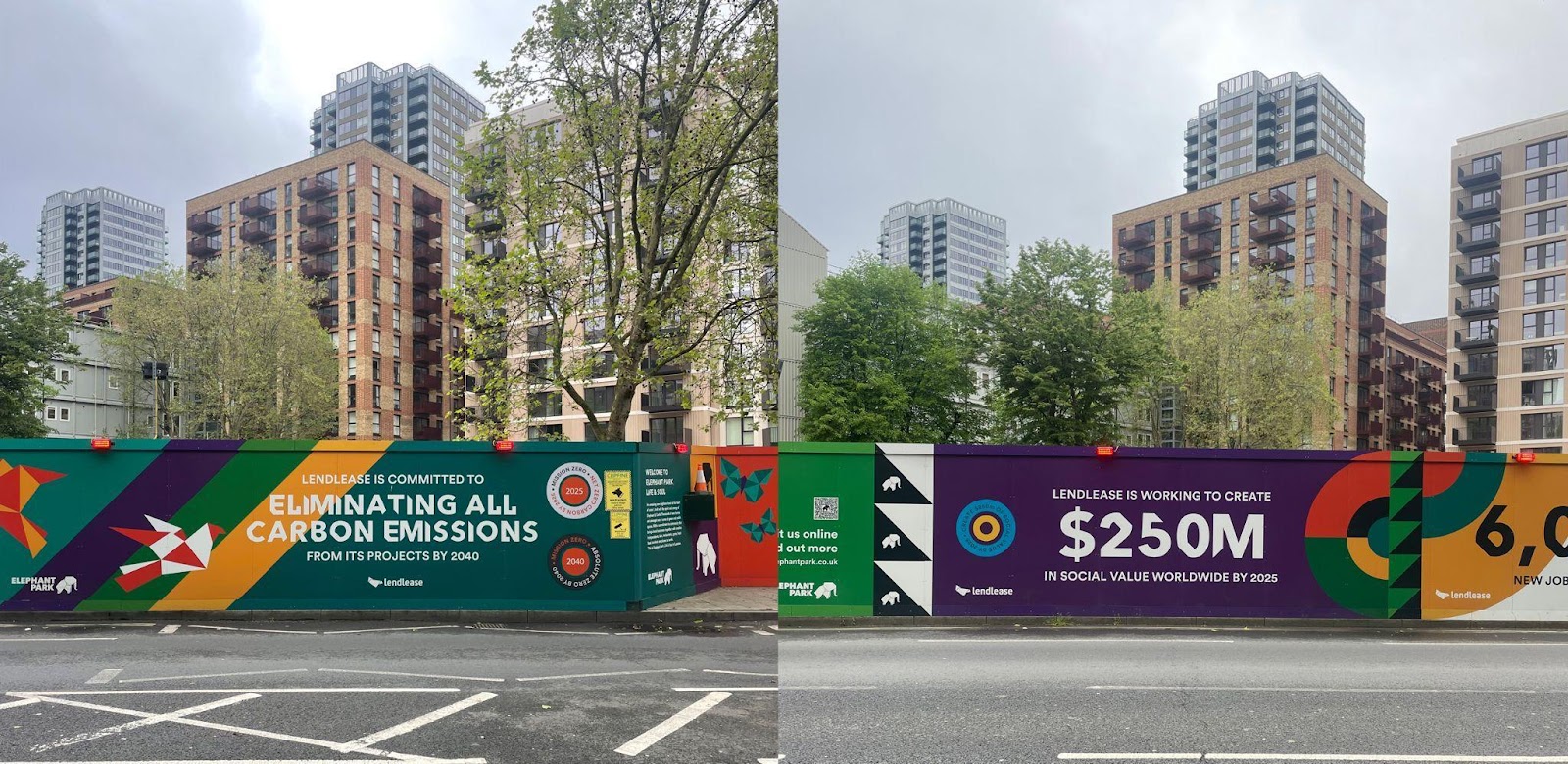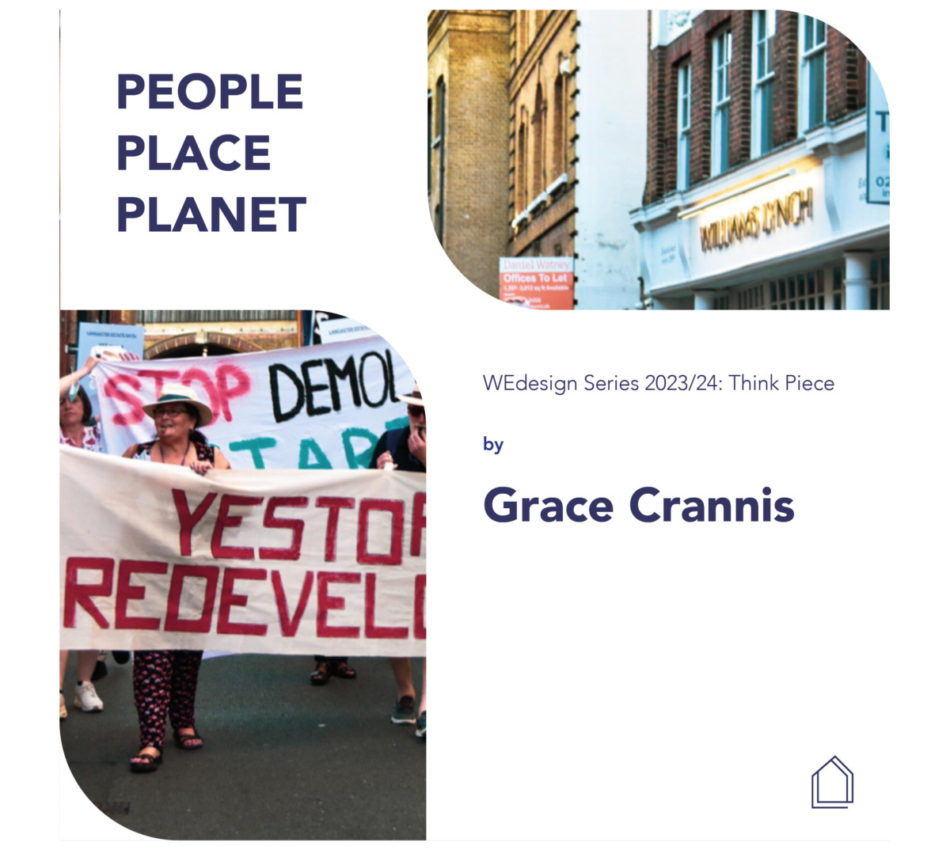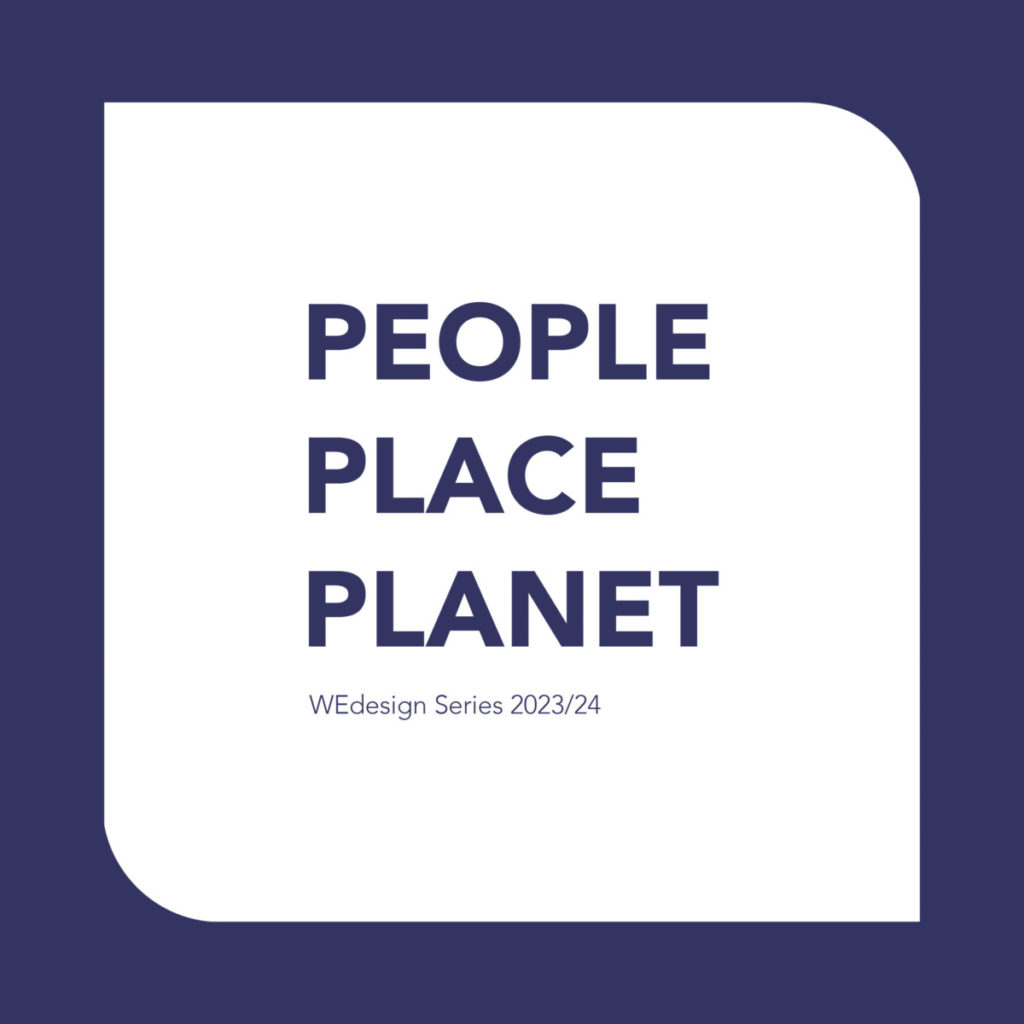Written by:
People, Place, Planet: Think Pieces, are a series of online blogs which will take our event series theme as a starting point and will offer an external voice and provocation.
In this edition of our People, Place, Planet: Think Pieces, Grace Crannis shares her thoughts and ideas about the theme through the lens of leadership and accountability in placemaking.
Sustainable, with care
Looking beyond green energy claims to make sure our places work for everyone
Placemaking is one of those broad, popular terms that can refer to anything from the act of bringing together people for a conversation about their area, to a programme of redevelopment that changes the core nature of a neighbourhood. ‘Sustainability’ as a term faces a similar fate: used to refer to both corporate PR campaigns and the vital initiatives that aim to mitigate the harm caused by rising global temperatures.
At the scale of large urban development, many schemes shout loudly about their sustainability credentials. Initiatives like urban greening or SUDS in the public realm, improved walking and cycling routes and newer, more energy efficient buildings are positive and much needed. But we are also all aware that there is nothing traditionally sustainable about the construction industry. It is one of the largest global polluters: huge amounts of natural resources are required in the process, as well as the polluting impact of demolition, waste and the logistics of construction.
To only view and celebrate sustainability in this narrow way without acknowledging the wider social and historic impact for communities, feels inauthentic.


Whilst some people may welcome the financial investment in their area that redevelopment or new transport infrastructure can bring, it is far from a straightforward process. Asset-poor Local Authorities in an unfavourable economic and political environment have turned to developer-led partnerships and their viability assessments to deliver much-needed homes. Where 1960s/70s era estates are demolished to make way for denser, more modern blocks. Affordable housing delivery typically relies on the sale of market rate flats – this is not necessarily a bad thing, but they are usually prohibitively expensive for local people. Where existing residents have been relocated away from the area, they find it almost impossible to return. Despite the green credentials of any new building or wildflower garden on the site, any claims feel hollow in context where public land was sold to developers and refurbishment was not pursued.
Estate infill is one way to increase the density of council-owned estates without demolition by building over garages, parking spaces or in some cases, communal greenspace. It can be controversial amongst residents, who are concerned about loss of mature trees, loss of daylight and impact on air quality. In these cases, the demand for housing outweighs the declaration of a climate emergency many of the same councils have made publicly. Difficult, unpopular decisions are sometimes required, but transparency throughout the process and collaboration around any estate improvements or additional shared facilities should be the only path forward.

Any process of urban change that does not meaningfully involve local people, or one that leads to a high turnover of residents or businesses through rising rents fuels the gentrification which changes the social fabric of a place. This will not create the sense of security and ownership required to live lower impact lives. It also reinforces the idea that energy efficient/sustainable/eco-friendly/ alternatives are for incoming, more affluent people, or improvements to the public realm or new transport infrastructure can only be achieved through displacement.

To find a more equitable way forward, we need to think holistically about what terms like placemaking and sustainability mean in practice for different communities, then be honest about the compromises and approach the process with care.
This means Local Authorities need to work collaboratively; ask tough questions; interrogate those public/private partnerships to make sure they really deliver for all communities; and work with a wider group of people to make decisions. We talk often about people in placemaking, but planners are not sociologists. In my experience it is unfortunately rare to have detailed conversations about the hidden ways places are used, the impact of who feels welcome and the impact policies might have on the makeup of communities.
We need to remember that creating healthy and sustainable places is about much more than physical change. Recently, teenagers in Richmond in South West London told us that when they spend time on the green, a spacious and leafy park, they are ostracised by older residents who call the police and post their faces on the Nextdoor app. Young people in many places struggle to find places to socialise safely and should be encouraged not shunned from spending time in their local park. If only certain groups are permitted to access greenspaces, that area is not working for all its communities.
In the post-industrial town of Roubaix in Northern France, where an estimated 46% of people live below the poverty line, they trialled a zero-waste composting scheme. After one year, 25% of households managed to reduce their waste generation by over 80% and 70% reduced it by half. Initiatives like this require few resources apart from time and bold leadership, but can have a hugely beneficial impact for places.
Recently, I’ve been exploring the role artists can play in the planning process to help explore more intangible qualities, bring new insight, or challenge assumptions. Injecting some excitement never hurts to make people feel included. Using creativity to start conversations about places is an excellent tool: we heard from people who told us they’d never taken the time or found the words to explain how they felt about their area. The approach of place-based artist Verity-Jane Keefe is a good reminder to think more widely about who is included in project teams, to slow down and to prioritise care and respect for communities.

Malmö in Sweden is one of the EU’s net-zero pilot cities. Whilst there is no consistent global definition of net-zero, in Malmö’s case, this means moving away from fossil-based fuels for greener energy; scaling up public transport investment and electrification; and working towards a circular economy that reduces emissions from construction and building operations, all by 2030. The city seems to approach this challenge with an ethos of collaboration. As part of their month-long programme, Malmö in the Making, held in September 2023, the city offered grants to multidisciplinary teams to explore questions like: ‘How can places be developed by taking care of what is already there? How far can change be made from the existing resources, materials, networks and people in a place? How could maintenance shape urban development?’.
If we aren’t creating and maintaining cohesive and inclusive places that support the needs of existing communities, it’s far more likely there will be problems to fix down the line. There is nothing sustainable about a cycle of building, demolition and rebuilding. Social sustainability is also a vital part of that balance, and we all need to be mindful of this dynamic.
My call to local authorities, planners, architects and developers:
- Use precise language. Claims that a new development achieves net-zero carbon is probably misleading, particularly if an existing building has been demolished in the process. Similar to saying co-design when you mean consultation, greenwashing damages transparency and limits meaningful action.
- Spend time understanding a place and listening before proposing changes to it. It sounds simple, but proper on the ground research before new policies, masterplans or architect’s briefs are written could go a long way to address some of the missteps. We need to think more broadly about the hidden ways places are used, often by the less vocal communities.
- Don’t just hire the same consultants. We need diverse teams from a range of different backgrounds. Give opportunities to smaller firms, hire people from working-class backgrounds and look at ways to involve artists, designers and researchers who can bring alternative points of view to the process.
- Give local people paid roles and training to enable and support participation. A few workshops with primary schools doesn’t cut it – we need to be more ambitious and acknowledge who is being paid to be in the room and who is missing. This requires the right teams to deliver such a programme, but it is something we should all be working towards.
- Think about sustainability broadly and at a range of scales. It’s not just about the big green promises. How much change is really needed, has that been considered from all perspectives, and how can people be supported through that process.
Sources / recommended reading:
A must-read: Municipal Dreams: the Rise and Fall of Council Housing by John Boughton
Housing regeneration examples:
Wandsworth Council’s 1000 homes infill scheme: press release on council website, 25.04.2023
Southwark Council’s infill programme: ‘The great ‘infilling’ debate in Southwark’, Southwark News, 25.08.2021
On demolition: ‘Is demolition ever the best way to regenerate?’ The Guardian, 04.06.2014
Changing Elephant and Castle: 35% campaign: https://www.35percent.org/
Failed regeneration in Hackney: ‘It was a case study for what not to do’: the regeneration project that became a £100m luxury ghost town’. Article in The Guardian, 11.11.2023
Low-impact examples:
Composting scheme in Roubaix: https://zerowastecities.eu/bestpractice/the-story-of-roubaix/
Verity Jane-Keefe: https://www.verityjanekeefe.co.uk/
Moorings Sociable Club: press release by Peabody Group, 14.09.2023
Malmö’s net zero ambitions: Net Zero Cities
Malmö in the Making: credit to City Architect Finn William’s instagram feed.
Leading collaborative projects:
Making the case for co-production, Future of London, May 2023Any resource by The Glass-House, including: Enabling Communities in Design Decision-Making, Sophia de Sousa, September 2023.
About the Author
Grace Crannis

Grace Crannis is a former Glass-House Design Champion. She is currently Senior Planning Engagement Officer at Richmond and Wandsworth Councils, Co-director of design studio Syrup, and Trustee of Turf Projects in Croydon.
About the WEdesign 2023/24 Series: People, Place, Planet
People, Place, Planet is our theme for The Glass-House 2023/24 WEdesign series.
As we continue to shape our places, we are faced with the huge challenge of balancing our personal needs, the collective needs of our communities and those of our increasingly fragile planet.
This series will aim to identify and explore the opportunities and synergies that exist when we strive to balance people, place and planet in placemaking.
How can we think differently about how we shape our places? How can we collaborate more through design and placemaking to value and respect people, place and planet equally?
To find out more about the full 2023/24 series, visit our People, Place, Planet page on The Glass-House website.
WEdesign is The Glass-House’s annual series of free interactive public events, held online and in-person in cities across the UK, where we explore collaborative design in placemaking through discussion, debate and playful co-design activities.
To find out more about the WEdesign Programme, visit the WEdesign page on The Glass-House website.
WEdesign is supported by the Ove Arup Foundation.

